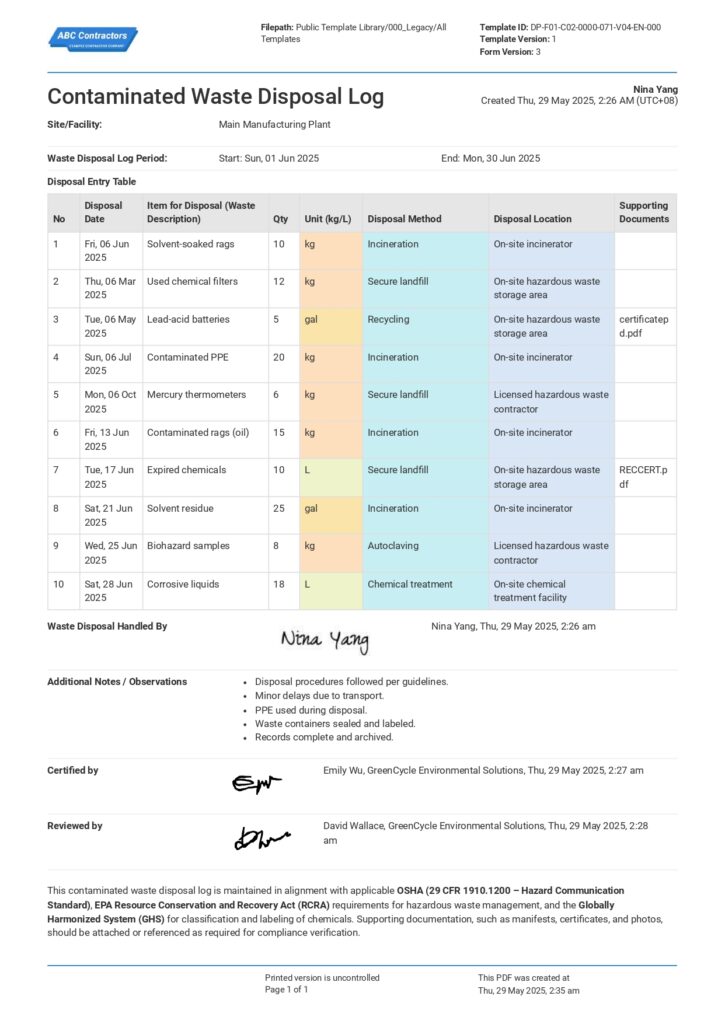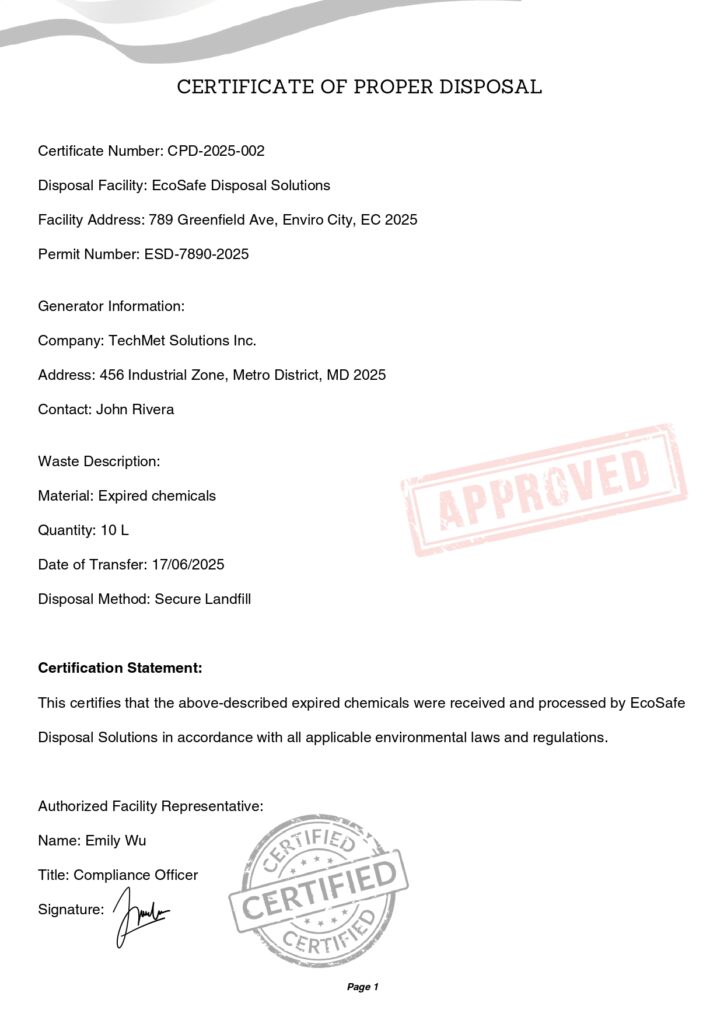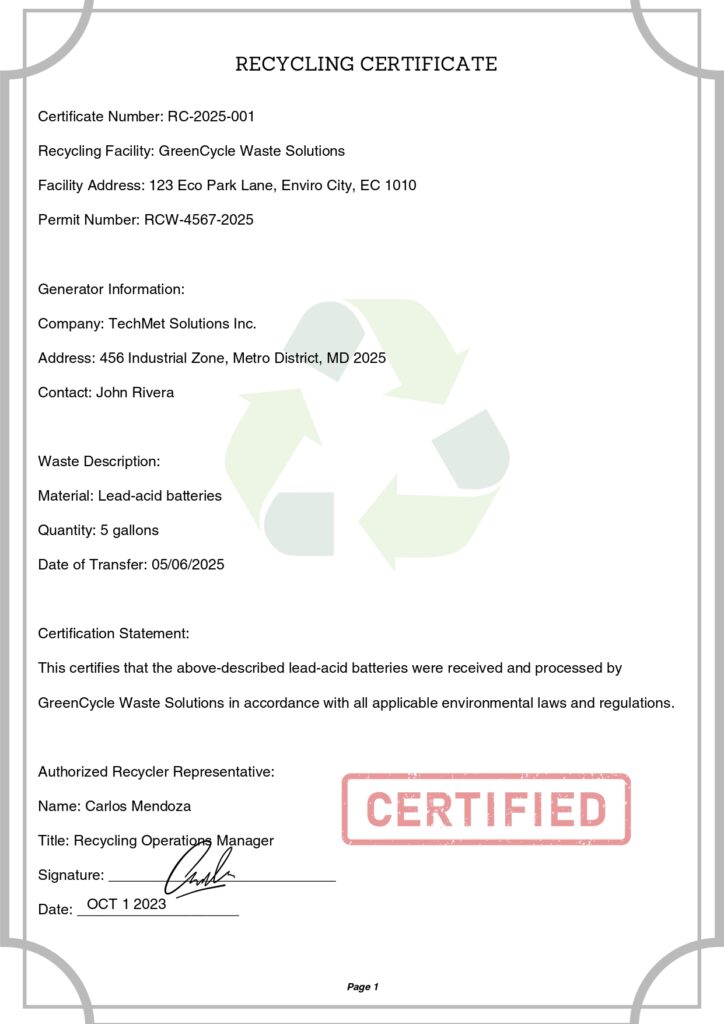Article Page – How to Dispose of Contaminated Waste
How to Dispose of Contaminated Waste
In this article, we will cover the importance of regulation and compliance for the disposal of contaminated waste, how to maintain a contaminated waste disposal log, guidelines for the proper disposal of contaminated waste, and seamless and easy the ways to stay compliant using free digital sources.
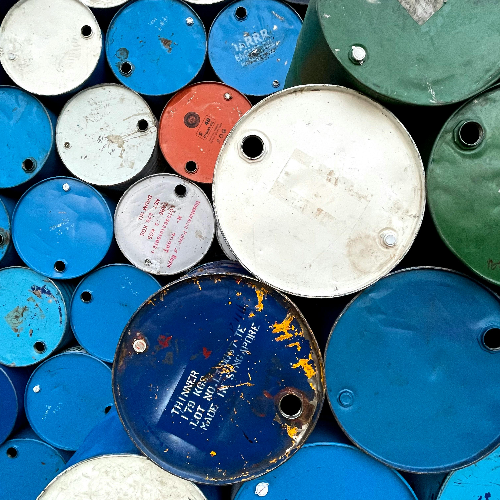
Table of Contents
Article Summary
- Maintaining an easy-to-update Contaminated Waste Disposal Log will help your company build a good structure in tracking disposal activities and ensure compliance.
- How to dispose of contaminated waste using the 3-step guide is to identify the contaminated waste, apply the "cradle-to-grave" principle, and follow the correct transport, treatment, and methods of disposal of contaminated materials.
- Use a solid and seamless waste and material documentation system to help you stay compliant of your disposals and documentations.
Why should disposal of contaminated waste be regulated?
Disposal of contaminated waste should regulated because it poses a risk to the health and safety of workers and the community upon exposure. Classification and segregation of contaminated waste are mandated by local and international regulations with strict controls.
Contaminated waste refers to materials that were used by human or animal sources, such as in the case of medical fields and laboratory facilities.
It can also come from tools and chemicals used in factories, which can still present a threat or greater risks to others when taken out of their previously controlled conditions.
For example, silver (Ag) paste, commonly used in electronics manufacturing and kept at controlled temperatures before use, can cause harm when improperly discarded after being subjected to high temperatures, oxidation, and solvent mixing, as it can interact with other substances.
With this, it’s very important to keep a Contaminated Waste Disposal Log that essentially records the amount of waste disposed, where it was disposed and the method it was disposed. This is not only for the purpose of monitoring the disposal, but it also ensures your company is compliant with environmental laws and regulations.
How to maintain a contaminated waste disposal log format?
To maintain a contaminated waste disposal log format, you first begin with the right procedure for waste segregation and classification, along with the right tools for recording and documentation. The correct procedure for segregation and classification of hazardous waste should follow a thorough review of the legislation in your country or state.
Usually, every country provides guidance on how and where to dispose of hazardous waste, and it’s good to rely on this so that your system is built to be compliant and ready for your state duties. In the UK, for example, the government has provided a comprehensive overview for identifying and disposing of hazardous waste whether you’re a waste producer or holder, carrier, or consignee.
When standards are identified, maintaining a contaminated waste disposal log will not be difficult if you use a structured and professional format.
Start with an easy-to-update form where you can input the details of the waste, such as type and weight, the disposal method, disposal location, photos if necessary, and other required information as mandated. Below is an example of a structured and professional document that you can easily update.
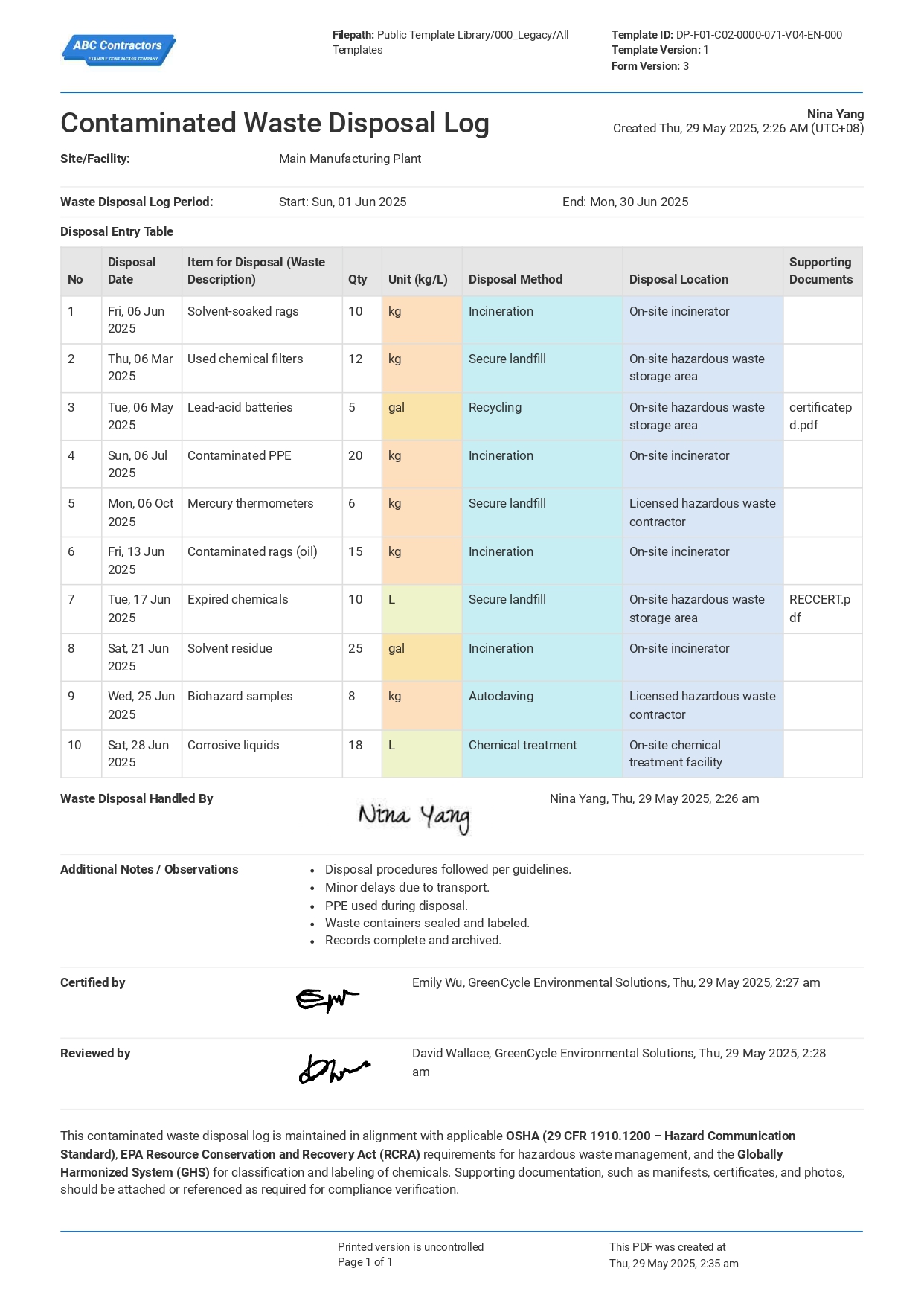
Use this Contaminated Waste Disposal Log for free
How to dispose of contaminated waste: the proper 3-step guide
Across countries, regulations can vary in terms of the proper disposal of contaminated waste. It’s best practice to align how to dispose of contaminated waste with the guidance of your respective regulatory body.
Below is a guide on how to dispose of hazardous waste in the workplace in 3 essentials steps. These steps are likely similar in different parts of the world, as they represent core practices.
Step 1: Identify the Contaminated Waste
Contaminated waste is waste that has been contaminated by a hazardous substance, whose exposure can cause harm to the health and safety of the worker or the community. Identifying contaminated waste involves defining both the contaminants and the waste they can produce.
While contaminated waste and hazardous waste are often used interchangeably, it’s important to distinguish that their sources are different.
There are materials that, from the source or supply, are already hazardous, such as sharp tools like needles, hand tools used for soldering, glass tools, and cartridges. These items are marked hazardous from the beginning because of their inherent risk; however, they can become more dangerous with added contamination.
For example, a sharp tool such as a needle is dangerous because it can cause cuts or punctures, but it can become contaminated with blood, chemicals, and other human or animal fluids that can cause the transmission of diseases, making it more critical. Identifying these items from hazardous waste to contaminated waste is the first step to proper disposal.
Step 2: Apply the “cradle-to-grave” principle in waste disposal
Regulatory authorities like EPA enforces the framework of “Cradle-to-Grave” Hazardous Waste Management Program, this emphasizes to industry producing waste to take strong and efficient actions to manage waste from “cradle” meaning from the time it is created, while it is transported, treated, and stored, and until “grave” when it is disposed. Terminology might be different in other countries or state, but the principle is the same and applicable.
There are standard waste containers, bins, and labels used to classify hazards, applicable from storage to disposal. The rules can vary by country or even by region, so make sure your team is staying updated. It’s important to not only check the visual classification of the disposal containers but also the font size and quality, to ensure they are leak-proof and that there is no chance of mixing them with other waste types.
Part of the segregation efforts of your company or facility also involves participating in recycling to balance resource conservation with the protection of human health, animal welfare, and the environment. The participation of industrial companies in this effort means ensuring that waste is stored, segregated, and disposed of correctly.
Step 3: Follow the right transport, treatment and disposal method
Following the right transport requirements means using licensed hazardous waste transporters or carriers. These transporters are licensed by a country or regions environmental agency, with valid registration certificates. Ensure to check how well they do their fleet maintenance through this article Fleet Maintenance Meaning and certification, so you won’t get caught with additional damage from transport issues.
Treatment and disposal methods vary, classified according to waste type and aligned with international best practices for environmental care. Each country has preferred methods—for example, the EU favors recovery over landfill, and Australia promotes on-site treatment as much as possible. Some of the most common methods are incineration, secure landfilling, autoclaving, chemical disinfection, radiation treatment, and deep well injection. We covered some of the definitions here.
When all these essential steps are done, you can build a Hazardous Material Safety Plan or a Hazardous Waste Management Plan to solidify your efforts of intentional and compliant proper waste disposal.
Disposal of contaminated materials and staying compliant
Whichever industry you may work with, you have an idea how hassle external audits and regulatory compliance can be at times. When you miss an internal audit or overlooked an update, there are facilities that struggle and scramble to do last minute changes because the current process flow is not up to date with the latest revisions.
Staying compliant and being compliant ready takes more than a singular instance, and when it comes to disposal of contaminated waste, it doesn’t have to be messy.
Know and stay up to date with the regulations for disposal of hazardous waste
This is a basic but very important method. It’s not just about knowing the policies but staying up to date by subscribing to newsletters and alerts and attending trainings and webinars discussing new legislation.
Some updates can be easy to follow, such as changes in font size for labeling containers, and easy to overlook, but auditors pay careful attention to stricter adherence to proper waste disposal, especially when there are incidents caused by poor segregation of contaminated waste.
For instance, in 2024, in the U.S., PFOA and PFOS (key PFAS chemicals) are now classified as hazardous substances under CERCLA. This can be overlooked, as prior to this, PFAS-contaminated waste residues were treated as non-hazardous, and their disposal method followed the standard waste stream. This oversight can result in additional cleanup costs and legal liability.
Implement and maintain policies and procedures aligned to the regulation
It’s always best practice to align the system to laws and regulations for waste disposal and a company has the freedom to add stricter rules, but the aim should be the same. It’s also ideal to create a system that can easily adapt to change. This system means having a management team to conduct internal audits, policy maintenance, and regular training. Having key persons to focus is the best way to implement the changes.
Use a solid and seamless waste documentation system
Making use of a highly functional smart Waste Tracking App and Software that can build and maintain documentations in a single platform would do wonders in a company it not only improves the workflow it also keeps the records safe as long as needed without finding it from filing cabinets like the old days.
A highly reliable contaminated waste and material documentation system is mandated by all major regulatory frameworks. Depending on where you are records are required to be kept at a certain period. Such as under UK regulations that requiring Duty of Care Waste Transfer Notes to be kept for 2-3 years in England and Wales.
Missing disposal logs, incomplete record of chemicals used or exposed to, missing incident reports can initiate a series of problems such as accidental exposure or inhalation of hazardous substance, spills, cross-contamination and infections.
Summary on how to dispose of contaminated waste
Waste disposal doesn't have to be messy when you follow the right steps and have a good system in place.
Smoother alignment and compliance to proper waste disposal regulations will also follow if your company culture cultivates an attitude of awareness and accountability, understanding that it would take everyone out of harms way when we follow the proper protocols.
Frequently Asked Questions
Is a Contaminated Waste Disposal Log required by local and international regulations?
Yes - Contaminated Waste Disposal Log is required by several regulatory authorities such as CCOHS, EPA, HSE as part of a company's record keeping efforts for accurate waste disposal.
How is technology influencing how companies do waste disposal, tracking, and documentation?
Technology is influencing and transforming waste tracking by replacing paper-based sysems with digital trackers from generators to disposal. The U.S has already enforced this back in 2018 through an e-Manifest system with EPA and the UK is transitioning to have mandatory digital disposal tracking service in 2026.
Does Sitemate offer other templates, logs, and forms specifically for waste disposal and tracking?
Yes - Sitemate offers ready-to-use waste disposal and tracking, even fully editable templates that can also be catered for your company policies and workflow. Businesses across various industries producing hazardous wastes are leveraging these templates, logs, forms, and documents right now to streamline their digital logs to improve retention and storage documentation.
Related resources
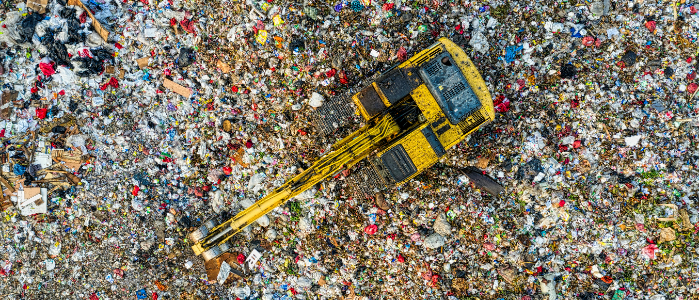
Landfill Checklist
Pre-built to easily check-off and verify quality of your landfill sites.
Waste Tracking Form
Say goodbye to manual spreadsheets for waste tracking and upgrade to this easy to manage form.

Hazard Waste Management Plan
The best way to manage hazardous waste and improve the workflow of waste disposal.
